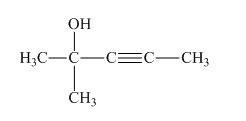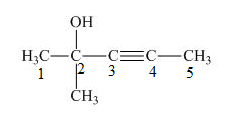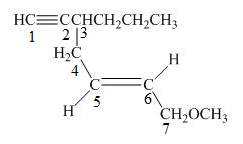
Concept explainers
(a)
Interpretation:
The substitutive name and common name of CH3CH2CH2CH2C≡CH are to be stated.
Concept introduction:
The systematic naming of organic compound is given by
Rules for writing IUPAC name from the structural formula are given below.
- First, identify the longest carbon chain.
- The next step is to identify the groups attached to the longest chain.
- Identify the position, location, and a number of the substituents bonded to the carbon chain.
- Use prefix di, tri, tetra if the same type of substituents is present.
- Name the substituents in alphabetical order.
Answer to Problem 14.3P
The common name of the compound CH3CH2CH2CH2C≡CH is butyl acetylene. The substitutive name of the compound is 1-hexyne.
Explanation of Solution
The compound CH3CH2CH2CH2C≡CH has an acetylene group (−C≡CH) in it which is attached to a four-carbon atom chain termed as butyl group. Therefore, the common name of the compound CH3CH2CH2CH2C≡CH is butyl acetylene.
The compound CH3CH2CH2CH2C≡CH has six carbon atom in the longest chain. Therefore, hex- will be used in prefix. The number of the carbon atoms will be started from the carbon atom which forms a triple bond.
The number on the carbon atoms in the compound is shown below.
C6H3C5H2C4H2C3H2C2≡C1H
The compound is
The common name of the compound CH3CH2CH2CH2C≡CH is butyl acetylene. The substitutive name of the compound is 1-hexyne.
(b)
Interpretation:
The substitutive name and common name of CH3CH2CH2CH2C≡CCH2CH2CH2CH3 are to be stated.
Concept introduction:
The systematic naming of organic compound is given by IUPAC nomenclature. The naming of organic compound is done such that the structure of the organic compound is correctly interpreted from the name.
Rules for writing IUPAC name from the structural formula are given below.
- First, identify the longest carbon chain.
- The next step is to identify the groups attached to the longest chain.
- Identify the position, location, and a number of the substituents bonded to the carbon chain.
- Use prefix di, tri, tetra if the same type of substituents is present.
- Name the substituents in alphabetical order.
Answer to Problem 14.3P
The common name of the compound CH3CH2CH2CH2C≡CCH2CH2CH2CH3 is dibutyl acetylene. The substitutive name of the compound is 5-decyne.
Explanation of Solution
The compound CH3CH2CH2CH2C≡CCH2CH2CH2CH3 has a acetylene group (−C≡C−) in it which is attached to two four-carbon atom chain termed as butyl group. Therefore, the common name of the compound CH3CH2CH2CH2C≡CCH2CH2CH2CH3 is dibutyl acetylene.
The compound CH3CH2CH2CH2C≡CCH2CH2CH2CH3 has ten carbon atom in the longest chain. Therefore, dec- will be used in prefix. The number of the carbon atoms will be started from the carbon atom which gives the lowest number to triple bond in the chain.
The number on the carbon atoms in the compound is shown below.
C1H3C2H2C3H2C4H2C5≡C6C7H2C8H2C9H2C10H3
The compound is alkyne. Therefore, -yne will be present as the suffix. The triple bond is present on the fifth carbon atom. The compound has ten-carbon atom long chain. Therefore, the substitutive name of the compound is 5-decyne.
The common name of the compound CH3CH2CH2CH2C≡CH is dibutyl acetylene. The substitutive name of the compound is 5-decyne.
(c)
Interpretation:
The substitutive name of compound is to be stated.
Concept introduction:
The systematic naming of organic compound is given by IUPAC nomenclature. The naming of organic compound is done such that the structure of the organic compound is correctly interpreted from the name.
Rules for writing IUPAC name from the structural formula are given below.
- First, identify the longest carbon chain.
- The next step is to identify the groups attached to the longest chain.
- Identify the position, location, and a number of the substituents bonded to the carbon chain.
- Use prefix di, tri, tetra if the same type of substituents is present.
- Name the substituents in alphabetical order.
Answer to Problem 14.3P
The substitutive name of the given compound is 2-methyl-3-pentyn-2-ol.
Explanation of Solution
The structure of the given compound is shown below.

Figure 1
The compound has five carbon atom in the longest chain. Therefore, pent- will be used in the root name. The number of the carbon atoms will be started from the carbon atom which gives the lowest number to hydroxyl group in the chain.
The number on the carbon atoms in the compound is shown below.

Figure 2
The compound has methyl group and hydroxyl group. Therefore, -yne will be present as primary suffix and –ol will be present on as secondary suffix. The methyl group is resent at the second carbon. Therefore, methyl will be used as prefix. The triple bond is present on the third carbon atom and hydroxyl group is present on the second carbon atom. Therefore, the substitutive name of the compound is 2-methyl-3-pentyn-2-ol.
The substitutive name of the given compound is 2-methyl-3-pentyn-2-ol.
(d)
Interpretation:
The substitutive name of compound is to be stated.
Concept introduction:
The systematic naming of organic compound is given by IUPAC nomenclature. The naming of organic compound is done such that the structure of the organic compound is correctly interpreted from the name.
Rules for writing IUPAC name from the structural formula are given below.
- First, identify the longest carbon chain.
- The next step is to identify the groups attached to the longest chain.
- Identify the position, location, and a number of the substituents bonded to the carbon chain.
- Use prefix di, tri, tetra if the same type of substituents is present.
- Name the substituents in alphabetical order.
Answer to Problem 14.3P
The substitutive name of the compound is 7-methoxy-3-propyl-5-hepten-1-yne.
Explanation of Solution
The structure of the given compound is shown below.

Figure 3
The compound has seven carbon atom in the longest chain. Therefore, hept- will be used in root name. The number of the carbon atoms will be started from the carbon atom which gives lowest number to propyl group in the chain.
The number on the carbon atoms in the compound is shown below.

Figure 4
The compound has propyl group and methoxy group. Therefore, methoxy and propyl will be present as suffix. The propyl group is present at the third carbon. The triple bond is present on the first carbon atom and double bond is present at the fifth carbon atom. Therefore, the substitutive name of the compound is 7-methoxy-3-propyl-5-hepten-1-yne.
The substitutive name of the given compound is 7-methoxy-3-propyl-5-hepten-1-yne.
(e)
Interpretation:
The substitutive name of compound is to be stated.
Concept introduction:
The systematic naming of organic compound is given by IUPAC nomenclature. The naming of organic compound is done such that the structure of the organic compound is correctly interpreted from the name.
Rules for writing IUPAC name from the structural formula are given below.
- First, identify the longest carbon chain.
- The next step is to identify the groups attached to the longest chain.
- Identify the position, location, and a number of the substituents bonded to the carbon chain.
- Use prefix di, tri, tetra if the same type of substituents is present.
- Name the substituents in alphabetical order.
Answer to Problem 14.3P
The substitutive name of the given compound is 1-penten-4-yn-3-ol.
Explanation of Solution
The structure of the given compound is shown below.

Figure 5
The compound has five carbon atom in the longest chain. Therefore, pent- will be used in root name. The number of the carbon atoms will be started from the carbon atom which gives lowest number to double bond in the chain.
The number on the carbon atoms in the compound is shown below.

Figure 6
The compound has hydroxyl group. Therefore, hydroxyl will be present as prefix. The hydroxyl group is present at the third carbon. The triple bond is present on the fifth carbon atom and double bond is present at the first carbon atom. Therefore, the substitutive name of the compound is 1-penten-4-yn-3-ol.
The substitutive name of the given compound is 1-penten-4-yn-3-ol.
Want to see more full solutions like this?
Chapter 14 Solutions
ORGANIC CHEM +SG +SAPLING >IP<
- Synthesis of 1-metilbenzotriazole from 1,2-diaminobenceno.arrow_forwardSynthesis of 1-metilbenzotriazole.arrow_forwardIndicate the formula of the compound, that is the result of the N- alquilación (nucleofílic substitution), in which an additional lateral chain was formed (NH-CH2-COOMe). F3C. CF3 NH NH2 Br о OMe K2CO3, DABCO, DMFarrow_forward
- Identify the mechanism through which the following reaction will proceed and draw the major product. Part 1 of 2 Br KOH EtOH Through which mechanism will the reaction proceed? Select the single best answer. E1 E2 neither Part: 1/2 Part 2 of 2 Draw the major product formed as a result of the reaction. Click and drag to start drawing a structure. Xarrow_forwardWhat is single-point calibration? Provide an example.arrow_forwardDraw the major product formed via an E1 pathway.arrow_forward
- Part 9 of 9 Consider the products for the reaction. Identify the major and minor products. HO Cl The E stereoisomer is the major product and the Z stereoisomer is the minor product ▼ S major product minor productarrow_forwardConsider the reactants below. Answer the following questions about the reaction mechanism and products. HO Clarrow_forwardjulietteyep@gmail.com X YSCU Grades for Juliette L Turner: Orc X 199 A ALEKS - Juliette Turner - Modul X A ALEKS - Juliette Turner - Modul x G butane newman projection - Gox + www-awa.aleks.com/alekscgi/x/Isl.exe/10_u-IgNslkr7j8P3jH-IBxzaplnN4HsoQggFsejpgqKoyrQrB2dKVAN-BcZvcye0LYa6eXZ8d4vVr8Nc1GZqko5mtw-d1MkNcNzzwZsLf2Tu9_V817y?10Bw7QYjlb il Scribbr citation APA SCU email Student Portal | Main Ryker-Learning WCU-PHARM D MySCU YSCU Canvas- SCU Module 4: Homework (Ch 9-10) Question 28 of 30 (1 point) | Question Attempt: 1 of Unlimited H₂SO heat OH The mechanism of this reaction involves two carbocation intermediates, A and B. Part 1 of 2 KHSO 4 rearrangement A heat B H₂O 2 OH Draw the structure of A. Check Search #t m Save For Later Juliet Submit Assignm 2025 McGraw Hill LLC. All Rights Reserved. Terms of Use | Privacy Center | Accessarrow_forward
- The electrons flow from the electron-rich atoms of the nucleophile to the electrons poor atoms of the alkyl halide. Identify the electron rich in the nucleophile. Enter the element symbol only, do not include any changes.arrow_forwardHello, I am doing a court case analysis in my Analytical Chemistry course. The case is about a dog napping and my role is prosecution of the defendant. I am tasked in the Area of Expertise in Neutron Activation and Isotopic Analysis. Attached is the following case study reading of my area of expertise! The landscaping stone was not particularly distinctive in its decoration but matched both the color and pattern of the Fluential’s landscaping stone as well as the stone in the back of the recovered vehicle. Further analysis of the stone was done using a technique called instrumental neutron activation analysis. (Proceed to Neutron Activation data) Photo Notes: Landscaping stone recovered in vehicle. Stone at Fluential’s home is similar inappearance. Finally, the white paint on the brick was analyzed using stable isotope analysis. The brick recovered at the scene had smeared white paint on it. A couple of pieces of brick in the back of the car had white paint on them. They…arrow_forwardCite the stability criteria of an enamine..arrow_forward
 ChemistryChemistryISBN:9781305957404Author:Steven S. Zumdahl, Susan A. Zumdahl, Donald J. DeCostePublisher:Cengage Learning
ChemistryChemistryISBN:9781305957404Author:Steven S. Zumdahl, Susan A. Zumdahl, Donald J. DeCostePublisher:Cengage Learning ChemistryChemistryISBN:9781259911156Author:Raymond Chang Dr., Jason Overby ProfessorPublisher:McGraw-Hill Education
ChemistryChemistryISBN:9781259911156Author:Raymond Chang Dr., Jason Overby ProfessorPublisher:McGraw-Hill Education Principles of Instrumental AnalysisChemistryISBN:9781305577213Author:Douglas A. Skoog, F. James Holler, Stanley R. CrouchPublisher:Cengage Learning
Principles of Instrumental AnalysisChemistryISBN:9781305577213Author:Douglas A. Skoog, F. James Holler, Stanley R. CrouchPublisher:Cengage Learning Organic ChemistryChemistryISBN:9780078021558Author:Janice Gorzynski Smith Dr.Publisher:McGraw-Hill Education
Organic ChemistryChemistryISBN:9780078021558Author:Janice Gorzynski Smith Dr.Publisher:McGraw-Hill Education Chemistry: Principles and ReactionsChemistryISBN:9781305079373Author:William L. Masterton, Cecile N. HurleyPublisher:Cengage Learning
Chemistry: Principles and ReactionsChemistryISBN:9781305079373Author:William L. Masterton, Cecile N. HurleyPublisher:Cengage Learning Elementary Principles of Chemical Processes, Bind...ChemistryISBN:9781118431221Author:Richard M. Felder, Ronald W. Rousseau, Lisa G. BullardPublisher:WILEY
Elementary Principles of Chemical Processes, Bind...ChemistryISBN:9781118431221Author:Richard M. Felder, Ronald W. Rousseau, Lisa G. BullardPublisher:WILEY





